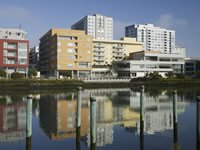Smart Growth and Equitable Development
On other pages:
Background

Every community has its own unique history and cultural assets. Many communities have established strong social networks and local knowledge that provide a strong foundation for community development investment. Many of these internal bonds are especially important in light of challenges such as proximity to polluting facilities, barriers to participating in decision-making processes, disproportionate levels of chronic diseases, neighborhood divestment and poor or no access to jobs and services. Many of these challenges are direct outcomes of how communities and regions are planned and built.
Smart growth can help address long-standing environmental, health, and economic challenges and facilitate community-driven solutions, through land use and development practices that:
- Reinvest in neighborhoods, clean up and reuse contaminated properties.
- Provide housing choices for people of all income levels, household sizes, and stages of life.
- Offer transportation options that are affordable, reduce air pollution and associated health impacts, and give residents who do not drive more mobility.
- Improve access to jobs and services by creating development that is walkable and transit-accessible.
Equitable development approaches create healthy and vibrant communities and regions, where all residents participate in and benefit from decisions that shape the place where they live.
Equitable development posits that the public has the right to inform decisions that could affect their environment and health. Decision-makers, including those at regulatory agencies, should seek out and facilitate the engagement of those potentially affected by their decisions and take their contributions into account.
Technical Assistance
EPA's Office of Community Revitalization has offered the following current and recent planning assistance, grounded in community engagement practices, to support communities in equitable development:
- Building Blocks for Sustainable Communities.
- Local Foods, Local Places.
- Recreation Economy for Rural Communities.
- Equitable Resilience Technical Assistance.
Community Projects
EPA developed reports from several past technical assistance projects that may inform communities in their own equitable development journey.
- Managing Vacant and Abandoned Property in the Green Zone of Saginaw, Michigan (2014): EPA worked with the community of Saginaw to identify options for developing a land use and infrastructure strategy that stabilizes neighborhoods through the sustainable reuse of abandoned properties, supports redevelopment of abandoned properties as green infrastructure, and creates opportunities for long-term economic growth. The final report provides information useful to any community seeking to return vacant and abandoned properties to productive use in a sustainable and economically resilient way.
- Public Involvement Plan and Toolkit for Las Cruces, New Mexico (2011): This Smart Growth Implementation Assistance project developed strategies to improve public engagement in community planning and design processes, focusing on populations which have traditionally had limited involvement in decision-making.
Data, Policy and Tools
- Attracting Infill Development in Distressed Communities: 30 Strategies (2015): Helps communities determine their readiness to pursue infill development and identify strategies to better position themselves to attract infill development.
- The Housing and Transportation Affordability (H+T®) Index (The Center for Neighborhood Technology): This tool calculates and maps location affordability based on combined housing and transportation costs.
-
The Ingredients of Equitable Development Planning: A Cross-Case Analysis of Equitable Development Planning and CDFIs (Join Center for Housing Studies of Harvard University, 2019): This report provides analysis of three equitable development campaign case studies from across the U.S. Each centers around a nonprofit community development financial institution (CDFI) and their efforts to spur equitable development through strategic capital investment and the formation of key community partnerships.
